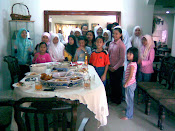18th November 2008
From the Grand Place, we proceed to the Atomium and Mini Europe. Both are situated next to each other. Due to time constraint, we can only choose one to explore further. We chose to just take photos at the Atomium and explore Mini Europe.
Some facts on the atomium :
Atomium, the most astonishing building in the world ranked as number 3 in Belgium on the list of Top 10 Adventures in Topworld
The Atomium is a monument built for Expo '58, the 1958 Brussels World's Fair. Designed by André Waterkeyn, it is 102-metres (335 ft) tall, with nine steel spheres connected so that the whole forms the shape of a unit cell of an iron crystal magnified 165 billion times.
Tubes which connect the spheres along the 12 edges of the cube and all eight vertices to the centre enclose escalators connecting the spheres which contain exhibit halls and other public spaces. The top sphere provides a panoramic view of Brussels. Each sphere is 18 metres in diameter. Three spheres are currently (2008) closed to the visitors, others are easily reachable with escalator. The vertical vertex contains a lift which was considered very fast and advanced at the time of building (the speed is 5 m/s)[1].
Renovation on the Atomium began in March 2004; it was closed to the public in October, and remained closed until 18 February 2006. The renovations included replacing the faded aluminium sheets on the spheres with stainless steel. To help pay for renovations, the old aluminium has been sold to the public as souvenirs. A triangular piece about 2 m long sold for €1,000.[citation needed]
The renovation includes revamped exhibition spaces, a restaurant, and a dormitory for visiting schoolchildren called "Kids Sphere Hotel" which features suspended plastic sphere towers. A €2 commemorative coin depicting the sculpture was issued in March 2006 to celebrate the renovation.
The Atomium is one of the most visited attractions in Brussels today. In 2008, the Atomium will celebrate its 50th Birthday, with activities planned all year, including free admission for those turning 50 between April and October.


 Hairul park the car infront of this planetarium. We walked to the entrance of Mini Europe which is quite a distance from the planetarium. It was raining and windy and cold. Temperature measured is 8° C but feels like 0° C. Since it was very cold, we walked thru all the monuments very quickly. To make it worse(anti climax), our camera's battery flat that leads to double frustration. Actually, I have forgotten to recharge the battery last nite. But that is not the end of the world. We still have our handphone and video cam. Is better than nothing..
Hairul park the car infront of this planetarium. We walked to the entrance of Mini Europe which is quite a distance from the planetarium. It was raining and windy and cold. Temperature measured is 8° C but feels like 0° C. Since it was very cold, we walked thru all the monuments very quickly. To make it worse(anti climax), our camera's battery flat that leads to double frustration. Actually, I have forgotten to recharge the battery last nite. But that is not the end of the world. We still have our handphone and video cam. Is better than nothing..



.jpg)
.jpg)
.jpg)
.jpg)
.jpg)
.jpg)

 Some facts on Mini Europe :
Some facts on Mini Europe :Mini-Europe is a park located in Bruparck at the foot of the Atomium in Brussels, Belgium. Mini-Europe has the reproductions of the most attractive monuments in the European Union on show, at a scale of 1:25. Roughly 80 cities and 350 buildings are represented. The park is renowned for the quality of its models, some of which cost as much as €350,000 to make (the Brussels Grand-Place). The park contains numerous live action models (train, mills, eruption of Mount Vesuvius, Airbus, cable cars, etc. A guide gives the details on all the monuments. At the end of the visit, the “Spirit of Europe” exhibition gives an interactive overview of the European Union in the form of multimedia games. The park is built on an area of 24,000 m2. The initial investment was of €10 million in 1989, on its inauguration by Prince Philip of Belgium
The monuments were chosen for the quality of their architecture or their European symbolism. After this initial selection process, plans and photos needed to be found. This stage cost over €200,000 in research. Most of the monuments are made using moulds. The parts are made from various types of material, and then copied using silicone moulding. The final copy used to be cast from epoxy resin, but now polyester is used. Three of the monuments were made out of stone (e.g. the tower of Pisa, in marble). A new computer-assisted milling procedure was used for two of the models. After that comes the painting. Finally, the monument is installed on site, together with decorations and lighting. The Cathedral of Santiago de Compostela required more than 24,000 hours of work. Many of the monuments were financed by European countries or regions.


















































.jpg)







0 comments:
Post a Comment